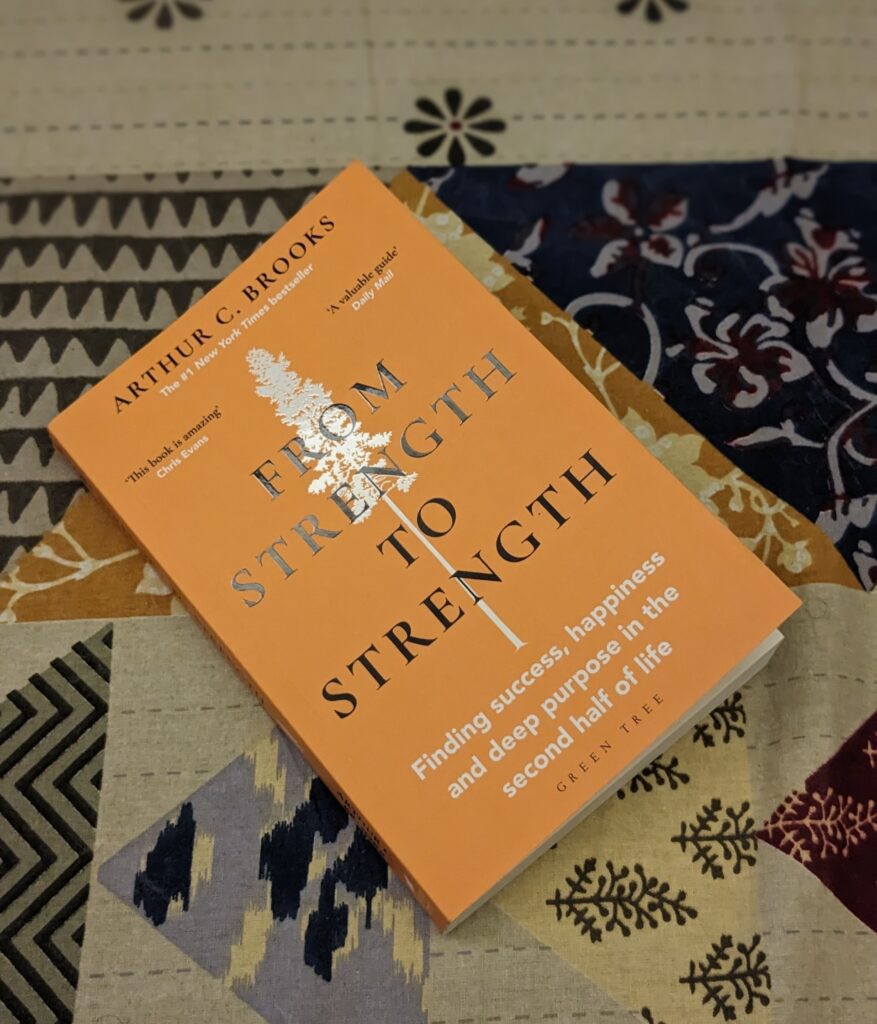Arthur C. Brooks
Quite a few of Arthur C. Brooks’ columns have resonated with me and also been thought-starters for some of my blog posts, so I was looking forward to ‘From Strength to Strength’. The premise is that in the first half of their lives, (most) people single-mindedly strive to be successful, often at the cost of health, relationships etc. But with age, many of the abilities that made them successful start to decline. They resent and resist this, leading to frustration and dissatisfaction. The book is about navigating the second half of one’s life when there are changes in mind and body, and the rules by which one worked and lived no longer seem to make sense. How does one get through this liminality, and thrive?
The book begins with one of his articles I had particularly liked – Your Professional Decline is Coming. I found this chapter very interesting thanks to the concepts that appear in it. For instance, “the principle of psychoprofessional gravitation”, the idea that the agony of decline is directly related to prestige previously achieved, and to one’s emotional attachment to that prestige. Also, the two kinds of intelligence – fluid intelligence, defined as the ability to reason, think flexibly, and solve novel problems, and crystallised intelligence, the ability to use a stock of knowledge learned in the past. The former is high in early adulthood, and starts to diminish in the thirties and forties. The latter starts growing from then on. Simplistically put, intelligence, and wisdom. The trick is to jump off from the first curve and on to the second in the later stages of life.
The book then moves on to how we objectify ourselves at work, and are addicted to the success it brings, making the jump to the second curve difficult. Many things are involved – pride, fear, social comparison, and a loss aversion that focuses on well, losing things like wealth, power, and fame one has amassed through hard work.
The rest of the book offers perspectives on how to get off the treadmill – mindfulness, finding friends and meaningful relationships, focusing on companionate love in marriage (rather than passionate love), facing one’s fear of death, distinguishing between intrinsic and extrinsic goals and focusing on the former, starting vanaprastha and understanding how to detach, finding a faith. I found this part not entirely different from things I have read in other books. I think I expected a bit more, but on hindsight, that’s an unfair expectation, since this is something one has to figure out independently, books and other people can only offer perspectives.
Having said that, ‘From Strength to Strength’ is a great start if you’re feeling the waves of midlife hit you. It provides context and perspectives to help you start framing the second half of life.
Notes
Fear of death: “thanatophobia.”Whether paralyzing or mild, the fear of death has eight distinct dimensions: fear of being destroyed, fear of the dying process, fear of the dead, fear for significant others, fear of the unknown, fear of conscious death, fear for body after death. and fear of premature death.
Edsel problem: The famous car that Ford executives loved, but consumers hated. They sell what *they* like, instead of what the consumers wants and needs. (in the context of helping people at our convenience and in our way)
“The worst thing about death is the fact that when a man is dead it is impossible any longer to undo the harm you have done him, or to do the good you haven’t done him.They say: live in such a way as to be always ready to die. I would say: live in such a way that anyone can die without you having anything to regret.” Leo Tolstoy


Leave a Reply